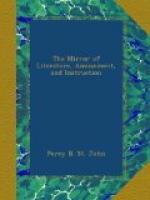MANNERS AND CUSTOMS OF ALL NATIONS.
* * * * *
No. XIV.
* * * * *
[Illustration]
The first of the above engravings represents one of the Body Guards of the Sheikh of Bornou, copied from an engraving after a sketch made by Major Denham, in his recent “Travels in Africa.” These negroes, as they are called, meaning the black chiefs and favourites, all raised to that rank by Some deed of bravery, are habited in coats of mail, composed of iron chain, which cover them from the throat to the knees, dividing behind, and coming on each side of the horse; some of them wear helmets or skull-caps of the same metal, with chin-pieces, all sufficiently strong to ward off the shock of a spear. Their horses’ heads are also defended by plates of iron, brass, and silver, just leaving room for the eyes of the animal; and not unfrequently they are hung over with charms, enclosed in little red leather parcels, strung together, round the neck, in front of the head, and about the saddle.
[Illustration]
Their appearance is altogether of a warlike character, the horses being well caparisoned, and the riders well clothed for personal defence; and though their equestrian evolutions be somewhat wild, the lance or spear is doubtless a formidable weapon in their hands. The savage splendour of their dress, together with the pawing and snorting of their fiery steeds, render them appropriate auxiliaries to royalty, in countries where such attributes of power are requisite to impress the people with the importance of their rulers, and where the milder aids of civilization and refinement are wanting to protect the sovereign from violence.
The second engraving, copied from the same authentic source as that preceding it, is a somewhat grotesque portraiture of one of the Lancers of the Sultan of Begharmi, described, in an historical and geographical account by a native prince, as an extensive country, containing woods and rivers, and fields fit for cultivation; but now desolated, as the inhabitants say, by the “misconduct of the king, who, having increased in levity and licentiousness to such a frightful degree, as even to marry his own daughter, God Almighty caused Saboon, the prince of Wa-da-i, to march against him, and destroy him, laying waste, at the same time, all his country, and leaving the houses uninhabited, as a signal chastisement for his impiety.”
Major Denham having applied for the covering of the above warrior and his horse, in his journal thus describes their arrival:—“Aug. 11. Soon after daylight, Karouash, with Hadgi, Mustapha, the chief of the Shouaas, and the Sheikh’s two nephews, Hassein and Kanemy, came to our huts. They were attended by more than a dozen slaves, bearing presents for us, for King George, and the consul at Tripoli. I had applied for a lebida, (horse-covering,) after seeing those taken from the Begharmis; the sheikh now sent a man, clothed in a yellow wadded jacket, with a scarlet cap, and mounted on the horse taken from the Begharmis, on which the sultan’s eldest son rode. He was one of the finest horses I had seen, and covered with a scarlet cloth, also wadded. ‘Every thing,’ Hadgi Mustapha said, ’except the man, is to be taken to your great king.’”




